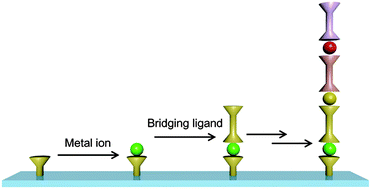π-Conjugated bis(terpyridine)metal complex molecular wires
Abstract
Bottom-up approaches have gained significant attention recently for the creation of nano-sized, ordered functional structures and materials. Stepwise coordination techniques, in which ligand molecules and metal sources are reacted alternatively, offer several advantages. Coordination bonds are stable, reversible, and self-assembling, and the resultant metal complex motifs may contain functionalities unique to their own characteristics. This review focuses on metal complex wire systems, specifically the bottom-up fabrication of linear and branched bis(terpyridine)metal complex wires on electrode surfaces. This system possesses distinct and characteristic electronic functionalities, intra-wire redox conduction and excellent long-range electron transport ability. This series of comprehensive studies exploited the customizability of bis(terpyridine)metal complex wires, including examining the influence of building blocks. In addition, simple yet effective electron transfer models were established for redox conduction and long-range electron transport. A fabrication technique for an ultra-long bis(terpyridine)metal complex wire is also described, along with its properties and functionalities.

- This article is part of the themed collection: Molecular Wires

 Please wait while we load your content...
Please wait while we load your content...